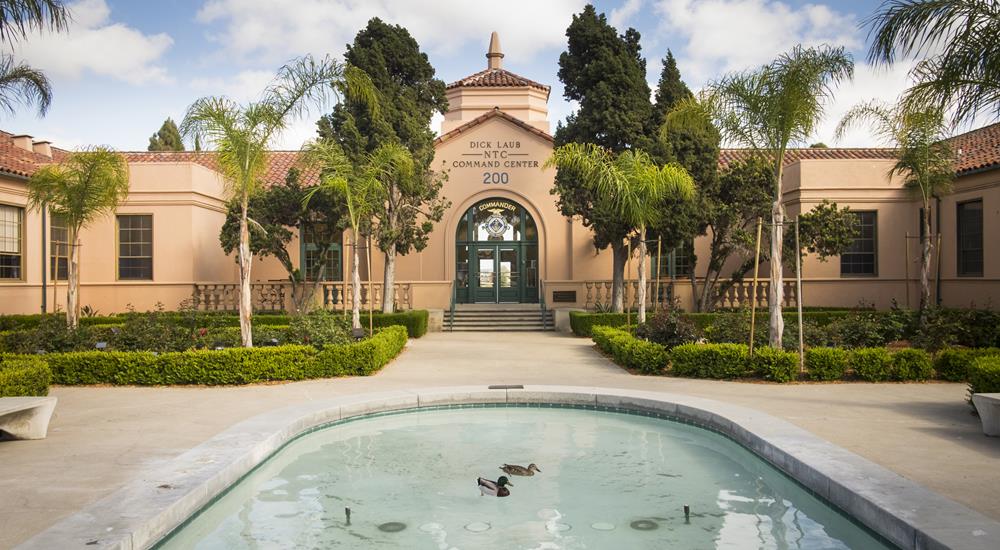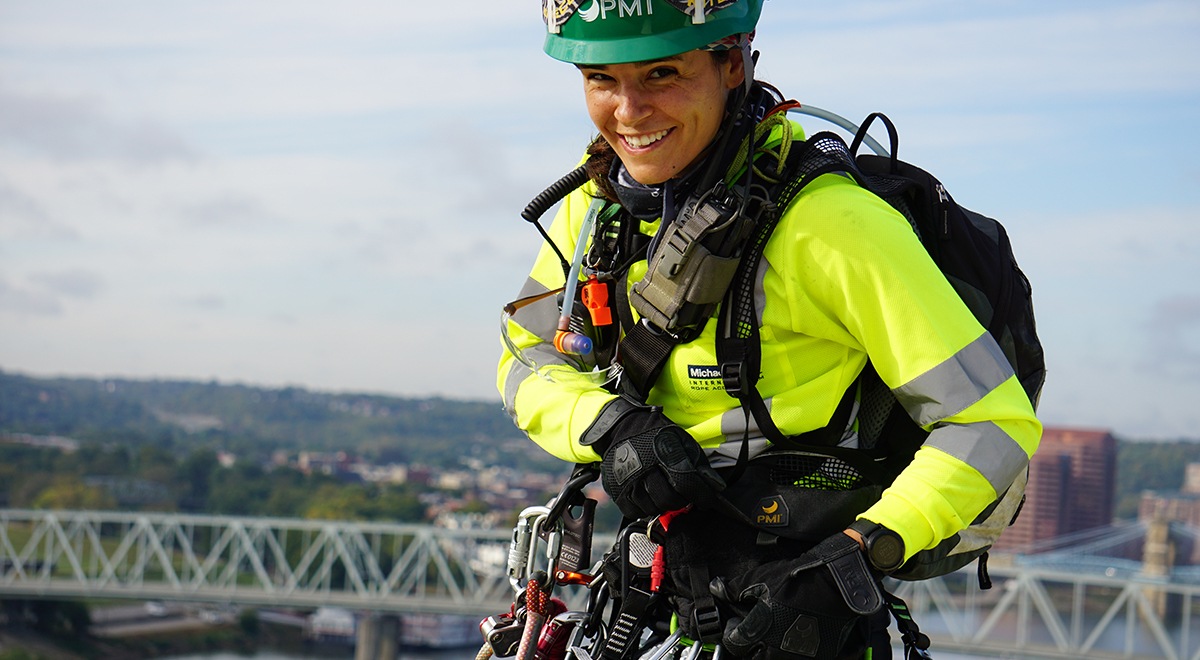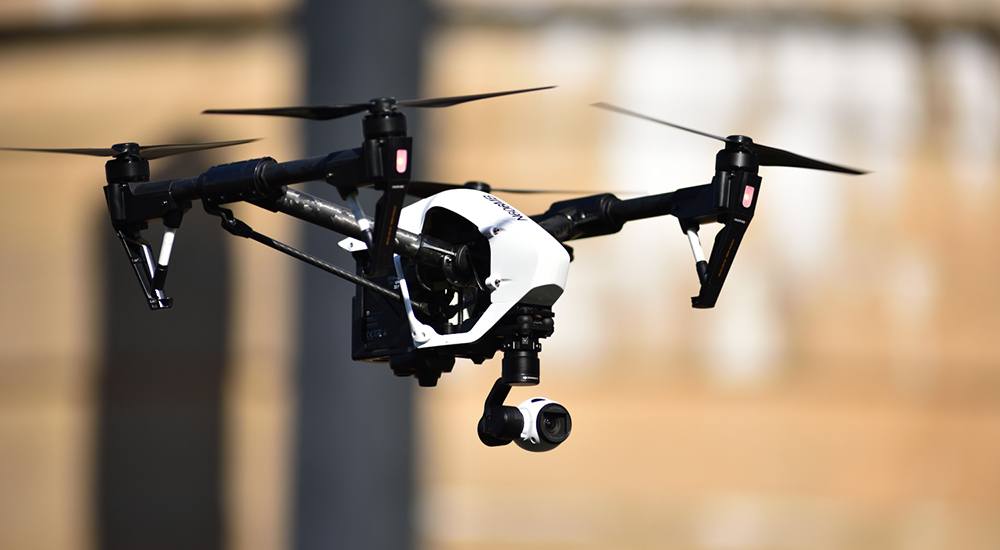Transforming Naval history into a vibrant new community
From the Fall 2016 issue of Signature
If you drive into San Diego’s Liberty Station through the northern gate and aren’t paying attention, you quite possibly could pass the historic mission-style sentry buildings, carved stone trim work and ornamental iron entry arch without even noticing the sign.
This unremarkable billboard to the left of the entry drive projects from the top of a tall, single blue pole above the sentry roof and into the southern California sun. But its straightforward message might very well sum up this community’s transformation – and Michael Baker International’s prominent role in supporting it – better than any National Register of Historic Places placard. It states, simply: “The future depends on what you do today.”
An apt message, perhaps, for many of the estimated 1.75 million young U.S. sailors who entered through that gate between 1923 and 1997 to receive training at what was once the 360-acre U.S. Naval Training Center (NTC) along San Diego Bay. The sign, whose origin on the base remains a bit of a mystery, seems to speak just as profoundly today to Michael Baker and others involved in planning and developing the NTC property’s future after the U.S. Navy decided to close the training center and turn it over to the City of San Diego.
Today, that future – as a massive mixed-use historical development with residential areas, business offices, retail shops, restaurants, hotels, schools, a megachurch, arts organizations, a public golf course, publicly accessible promenades and a 46-acre public waterfront park – has never looked so good.
“What’s most significant about this project,” says Rob Gehrke, a vice president of Michael Baker based in San Diego and project manager for the Liberty Station project, “is that we took this major piece of San Diego’s and the country’s history and preserved the integrity of its past while providing for the region a dynamic economic boost. Today, it’s a thriving development that attracts thousands of residents and visitors. It has become a local hotspot.”
Engineers who later would become part of Michael Baker worked on the project from as early as 1992. They helped the Navy, in collaboration with the city, historical societies, economic development agencies, arts organizations and other interested stakeholders, to determine re-use of what the city considered prime real estate along the bay, at the edge of Point Loma. In fact, the development sits directly across the bay channel from San Diego International Airport, with the city’s skyline only a few miles beyond that.
Eventually, the Michael Baker team of engineers would participate in determining which historical buildings to keep. They would map existing “horizontal” infrastructure and conduct hazardous materials surveys. And they would wrestle with challenges such as stabilizing the soil and complying with Americans with Disabilities Act regulations while having to preserve original sidewalks and curbs, among other major infrastructure considerations.
SOMETHING FOR EVERYBODY
It certainly didn’t transform overnight, though. To help move the project forward, Michael Baker engineers developed a public participation program to share with the community the benefits of a Navy family housing development on the property and ultimately worked with the Navy to select the right builder for that job.
“We were asked to become members of a Navy technical advisory board, and we performed studies and made recommendations for the best use of the property,” Gehrke says of the engineering team. “We helped to facilitate the Navy’s agenda, and that housing development is a beautiful project today.”
Then in 1995, two years before the NTC’s final closure, the Navy transferred the remainder of the property to the city through an economic development conveyance.
The city’s ultimate plan, according to Gehrke, was an extensive redevelopment effort that would honor historic designations, limit changes to historic infrastructure and remap the base into seven separate districts.
The first order of business, he says, was to conduct a master grading study for NTC to set the stage for the “unitization” and redevelopment, with stormwater issues creating one of the greatest development challenges. The stormwater quality had to be approved by the California Coastal Commission, which required an extensive stormwater treatment train approach aimed at cleaning the stormwater before entering into San Diego Bay. The district mapping would require distinct considerations for residential, education, arts groups, commercial, hotels and public spaces, all packaged in a way that would blend well with the character of the existing adjacent Point Loma community.
The city awarded the NTC Redevelopment Project to local developer Corky McMillin Companies and entered into a disposition-of-development agreement with the developer to make sure the project adhered to the strict parameters that had been established in the exhaustive re-use plan.
“Our company’s integrity and reputation enabled us to win this project,” says a broad-shouldered, animated Mark McMillin, president and CEO of Corky McMillin Companies and son of the late Corky McMillin, who drove this project in its early phases. “My dad loved challenges. We looked at this as a family legacy. We’re very happy with how it’s turning out.”
The city’s vision for this redevelopment site – and ultimately, McMillin Companies’ plan – called for seven distinct districts within the boundaries of Liberty Station, including the following: the NTC Promenade, a 28-acre parcel that includes 26 historical buildings for arts and cultural organizations; a 22-acre educational district that includes a technology-focused high school, “Maker’s Foundry,” grade school and private church-run school; a 37-acre residential district with 350 single-family and multi-family homes; an office district with seven Class A office buildings and 380,000 square feet of space; a waterfront hotel district; a retail and restaurant area utilizing at least 27 historic buildings; and 125 acres of public open space, including a waterfront “Esplanade” and a nine-hole executive golf course.
Numerous maps showcase the grand plan. A giant three-dimensional model of the development adorns the marble entryway of McMillin Companies’ corporate headquarters office, which anchors Liberty Station’s business district. Nothing brings the plan to life today like a drive through the actual development, where thousands of people now live, work, shop, splash in the public fountains, stroll and otherwise take in views of the nearby airport, cityscape, bridge to Coronado Island and passing ships on the bay.
WAR ROOM IN BUILDING 23
What the maps, models and current hustle and bustle of a now-vibrant showcase community don’t reveal, though, are the seemingly countless hidden challenges – many literally underground – that tested the expertise, experience and problem-solving abilities of the Michael Baker team and others throughout this long redevelopment journey.
Following the Michael Baker team’s initial work with the Navy, McMillin Companies then hired the team to serve as the master engineer on the project, beginning in 1999, with a site development plan incorporating an estimated $130 million in required infrastructure improvements.
“It was a classic land redevelopment project,” Gehrke says. “We worked for the developer on the implementation side and had to deal with land issues such as grading, drainage, utilities, Americans with Disabilities Act compliance, roads, traffic improvements and bad soil. Technically, it presented many challenging issues for us to resolve.”
That’s where a historic structure known as Building 23 played a catalyzing role. Gehrke affectionately refers to that building, which is located within the heart of Liberty Station’s historic retail district, as the War Room.
There, he and a team consulted daily with the developer and numerous subcontractors on a long list of infrastructure issues and unforeseen buried obstacles.
The Michael Baker team also prepared the master grading studies to establish the concept to systematically design and construct the 360-acre development. Driving the grading studies were the challenges associated with both the constraints of existing gravity-based storm drains and sewers on flat ground.
“Through our creative efforts, we were able to eliminate the sewer injector pumps, which gained Coastal Commission support and would require less ongoing maintenance,” Gehrke says.
Adds McMillin of the Building 23 team: “We had some great consultants. We couldn’t do this without our consultants. The [Michael Baker] guys are the best in San Diego.”
WAR ROOM CHALLENGES
To a large extent, “unforeseen challenges” defined much of the infrastructure development efforts, given the property’s 74-year history.
“It took a lot of time and energy as we ran into ‘unforeseen conditions’ throughout the duration of the project,” Gehrke says of those obstacles. “Records were poor, and we had lots of undocumented utilities, hydrology issues and soil problems. But we figured out how to solve them and moved forward.”
For instance, as Gehrke describes it, a “severely undersized” storm drain system ran down from the Point Loma community through the Liberty Station property at more than full capacity, according to engineering studies conducted on the drainage system. That was to be expected.
What the team hadn’t anticipated was the discovery of a 30-inch trunk sewer running perpendicular through that same drainage system. The team’s solution: Design a new storm drain system connecting to the existing outfalls at the waterfront, which runs along the edge of the property.
The property’s soil presented its own complications. It turns out that the property originally was considered tidelands and had been built up with deposits that had been dredged from San Diego Bay. That left the low-lying property susceptible to “liquefaction,” a phenomenon triggered by excess water or earthquakes that cause the ground to react like quicksand.
To effectively build on that land, Gehrke says, the team (which included a soils engineering company), had to devise solutions to provide “deep dynamic compaction” of the soil by dropping 150-ton weights systematically across the soil, particularly in the residential district where the developer planned to build the 350 row homes, townhomes and multi-family homes. The Michael Baker team also performed the supporting engineering for the construction of the specific home sites. Ultimately, the new homes became a hit in the local market and were honored with numerous awards.
Among other obstacles: The design team had to work around existing jet fuel lines that ran through the length of the property, as well as a 69 kv electrical distribution line.
The team also had to work around the FAA middlemarker and airport strobe lights that were on the property. They had to remain powered and undisturbed at all times to provide aircraft guidance and assist pilots with landing their aircrafts at San Diego International Airport’s nearby runways.
LIVING LEGACY
Today, families live in all 350 housing units. Classrooms in the education district foster technology and creativity. The Rock Church attracts upwards of 12,000 attendees to its worship services weekly and many kids to its K-12 school. The waterfront park, called the Esplanade, swarms with walkers, bicyclists, and parents with young children all along the 46-acre green space. The retail district houses a large grocery store, hardware store and a series of boutiques within its arcades, which are connected by long and public promenades and central plazas.
Recently, in fact, the Liberty Public Market opened for business inside a sprawling historic building across the street from Building 23, resembling the likes of the famous Reading Terminal in downtown Philadelphia and Faneuil Hall Marketplace in Boston.
“During the many years of design, we often walked the site to note existing conditions,” Gehrke says of the new public market and the swarming pedestrian traffic around it during a typical weekday. “We always tried to envision the final product and what success might look like. It’s great now to see the vibrancy of people going to the public market and living here.”
Still, 14 years later, the redevelopment effort continues, with ongoing guidance from Michael Baker. A large cinema currently is being built, and Mark McMillin says his family’s company is contemplating plans to transform another section of historic barracks buildings and promenades on the northern end of the site into a trendy boutique hotel.
On the southern end, closest to the bay, a large pedestrian bridge connects to another parcel, where excavators and bulldozers currently prepare the land – another Liberty Station parcel mapped out and planned initially with guidance from Michael Baker – for additional hotels and conference facilities.
Gehrke, serving as a tour guide one recent spring afternoon as he drove a group around Liberty Station on an oversized golf cart, beamed as he pointed out landmarks, greenspace, grassy fi re lanes and of course the people, seemingly everywhere, from one Liberty Station district to the next.
Says Gehrke: “It’s very satisfying to have been part of a team that helped transform this property into this very successful redevelopment project.”




